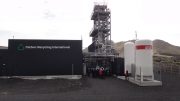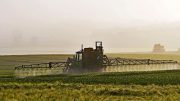 Are American lawns beautiful visions of nature? Or ecological calamities? Unfortunately, the grass leaves in our parks leave havoc in their wake. Lawns are extremely costly in many ways, including dollars spent on them, the deadly consequences of fertilizer and pesticide use, watering, and mowing. Carbon dioxide (CO2) and other greenhouse gases emitted during these stages of lawn care contribute climate change.
Are American lawns beautiful visions of nature? Or ecological calamities? Unfortunately, the grass leaves in our parks leave havoc in their wake. Lawns are extremely costly in many ways, including dollars spent on them, the deadly consequences of fertilizer and pesticide use, watering, and mowing. Carbon dioxide (CO2) and other greenhouse gases emitted during these stages of lawn care contribute climate change.
There are various estimates of how much land in the United States is covered by turfgrass. Turfgrass is defined as any of various grasses grown to form turf.
Turf is defined as the grass and the surface layer of earth held together by its roots. A new study from NASA finds that there are 63,248 square miles of lawn in America. Another study published in Environmental Management found that turfgrass covers 1.9% of the US, including 700,000 athletic fields and 14,500 golf courses. Many sources state that turfgrass is our largest agricultural crop. An article in Science Line titled “Lawn Vs. Crops in the Continental U.S.” states that “there may be more acres of lawn than of the [combined] eight largest irrigated crops.”
According to Lawn People: How Grasses, Weeds, and Chemicals Make Us Who We Are, based on calculations from air photography and tax assessments, 23% of urban areas are covered in turf. According to a 2005 NASA study, lawns cover 10% of Delaware and 20% of Connecticut, Rhode Island, Massachusetts, and New Jersey. Standard grass lawns are very expensive. They require more equipment, labor, fuel and use more agricultural toxins than industrial farming, therefore making them the largest agricultural sector in the US. According to the Economic Research Service, Americans invest roughly $60 billion a year in the turfgrass industry, including lawn care products and engaging lawn care companies. Besides being overly expensive, lawns are incredibly time-consuming. Americans spend more than three million hours per year pushing or riding lawnmowers. It has been estimated that the average American mows their lawn 22 times per year.
According to the online site “People Powered Machines,” about 54 million Americans mow their lawns every weekend. Using lawn equipment also significantly adds to noise pollution. The World Health Organization recommends that general daytime outdoor noise levels should not go above 55 decibels. According to Lawn and Landscape Maintenance, the average leaf blower produces 70-75 decibels at 50 feet. And the time spent mowing lawns is disliked by millions of Americans. A study conducted by the Consumer Reports National Research Center in 2008 found that 58% of those polled do not enjoy mowing their lawns.
Moreover, lawn fertilizers are used much too extravagantly. It is estimated that Americans use ten times more fertilizer on lawns per acre than they do on food crops. According to the Environmental Protection Agency (EPA), in 2004 Americans used 70 million pounds of fertilizers on their lawns. According to an article in the June 24, 2011 issue of The Week, Americans use 90 million pounds of fertilizer on their lawns every year.
The manufacturing of synthetic fertilizers leaves a large carbon footprint leading to climate change. Carbon dioxide (CO2), nitrous oxide and methane are produced during the fabrication of fertilizers. In an article titled “Energy Consumption and Greenhouse Gas Emissions in Fertilizer Production” published by the International Fertilizer Association it is estimated that fertilizer production consumes approximately 1.2% of the world’s energy and is responsible for 1.2% of total greenhouse gas emissions. For every ton of fertilizers manufactured, two tons of carbon dioxide are produced.
Most conventional fertilizers are produced using ammonia, which is extracted from natural gas, and two-thirds of natural gas is obtained by fracking. Therefore, lawns also contribute to all of the environmental damages, including water pollution, caused by fracking.
Besides the manufacturing of fertilizer leading to climate change, the actual use of fertilizer also contributes to climate change. Research from Michigan State University, in a study published in the Proceedings of the National Academy of Sciences, finds that any nitrogen not used by plants is converted by soil microbes into nitrous oxide, a greenhouse gas estimated to be approximately 300 times more potent than CO2. The University of Florida’s Institute of Food and Agricultural Sciences estimated that a 9.88-acre plot in Miami-Dade, in which 85% of the area is covered by lawns, emits over 11 tons of CO2 per year.
Additional evidence of fertilizer use causing climate change is found in research from Dr. Chuanhui Gu, a professor in the geology department at the Appalachian State University. Dr. Gu and his co-authors, in a paper published online January 9, 2015, by the Journal of Environmental Management, found that a 2.47-acre plot of lawn in Nashville, Tennessee, produces greenhouse gases equivalent to up to 2,443 kg of CO2 per year.
This is equivalent to the amount produced by a flight more than halfway around the world. Dr. Gu also states that standard lawns emit about 5 or 6 times more CO2 than what is absorbed during photosynthesis. Nitrous oxide emissions from fertilizers lead to an estimated total equivalent of about 25 million tons of CO2 each year in the US. Gu adds that if clippings were left to decompose on lawns, the US could store up to 16.7 teragrams [16,700,000 tons] of carbon each year in the soil.
Moreover, synthetic nitrogen fertilizers also damage the soil as shown in an article titled “Synthetic Nitrogen Fertilizers Deplete Soil Nitrogen: A Global Dilemma for Sustainable Cereal Production” in the Journal of Environmental Quality. These researchers found that synthetic nitrogen fertilizers were causing the loss of soil carbon and organic nitrogen leading to erosion and runoff. This runoff contributes to water pollution and less sequestration of CO2 in the soil leading to more climate change.
Some runoff from synthetic fertilizers reach wells and contaminate water. Wells with high concentrations of nitrates may cause congenital disabilities, blue baby syndrome, nervous system impairments and cancer. Other runoff contaminated by fertilizers eventually reaches streams, lakes, and estuaries and then finally our oceans. Nitrogen and phosphorus from fertilizers result in excessive growth of water plants, and they initially flourish.
However, these plants die and sink to the bottom where they decompose resulting in less oxygen in the water. Since fish and other aquatic animals require oxygen, the lowered oxygen levels from eutrophication cause dead zones, defined as an area of water in which the concentration of oxygen is so depleted that most life cannot be sustained. In 2008 it was estimated that there were more than 400 dead zones in the world’s oceans. The dead zone in 2016 from nitrogen runoff in the Gulf of Mexico was the size of Connecticut.
Along with fertilizers, pesticides contribute to climate change because they are manufactured using petroleum products, and energy is also used during the manufacturing process and for transportation. Around 78 million US households use pesticides on their yards each year, according to Beyond Pesticides. According to an article in the June 11, 2011 issue of The Week, an estimated 78 million pounds of pesticides are used yearly on our lawns. Weed killers are the most used chemical with 90 million pounds of herbicides being used on lawns every year according to the Pesticide Action Network.
One danger of lawn chemicals is that they are tracked into our homes, thus placing our pets and small children in danger. Small children are at particular risk since their developing bodies are far more vulnerable to toxins. The National Cancer Institute states that children in households that have lawns treated with pesticides have a 6.5 times greater risk of developing leukemia.
Watering our lawns is another way that lawn practices increase climate change. A large amount of energy is used in purifying, transporting, and irrigating with water which is provided by local governments. Thus, our lawns are subsidized by the government. Much of that water is wasted as studies have found that twice as much water as lawns need is used on lawns.
A 2005 NASA study found that in terms of surface area residential and commercial lawns are the single largest irrigated crop in America. Christina Milesi, one of the study’s researchers, told NASA’s Earth Observatory that she estimated that there are three times more acres of irrigated lawn in the US than irrigated corn. She put the practice of watering our lawns in perspective by stating that farmlands consume 88.5 million acre-feet of water per year in contrast to lawns which use two-thirds as much and that most municipalities use 30 to 60% of their water on lawns. The EPA’s figures agree with these percentages of water used on lawns.
The total estimation of greenhouse gas emission from lawn care, which includes fertilizer and pesticide production, watering, mowing, leaf blowing and other lawn management practices, was found by a University of California-Irvine study to be four times greater than the amount of carbon stored by grass. In other words, our lawns produce more CO2 than they absorb.
Even the lawn mowers that we use are responsible for greenhouse gases. It is complicated to ascertain how many lawn mowers exist in the US. One article found on the online site NBCNews.com provided an estimate by the owner of the American Lawn Mower Co. that 350,000 manual mowers are sold in the US each year. The article also stated that 6 million gas-powered walk-behind mowers were on the market in 2006. According to the online site HBS DEALER, the 2009 lawn mower sales were about 3.2 billion dollars. CO2 is also produced in the manufacturing, transportation, and disposal of these lawn mowers.
The process of mowing lawns produces a large amount of CO2. Scientists use different criteria from each other and therefore their statistics vary from each other. Thus, there is quite a significant difference in the estimates of how much gas lawnmowers use. According to the EPA, the figure is 580 million gallons of gas per year whereas the Department of Energy’s value is 1.2 billion gallons per year. Estimates vary from 16 billion to 41 billion pounds of CO2 being emitted from lawn mowers every year.
Another estimate is that every gallon of gasoline burned by lawnmowers emits 20 pounds of CO2. According to the EPA, one gas lawn mower emits 89 pounds of CO2 and 34 pounds of other pollutants per year. According to a Swedish study, using a mower for one hour has the same carbon footprint as a 100-mile car trip. The EPA found that gasoline-powered lawn mowers emit eight times more nitrogen oxides, 3,300 times more hydrocarbons, 5,000 times more carbon monoxide and more than twice the CO2 per hour of operation than electric lawn mowers.
Lawn mowers are not the only cause of greenhouse gases produced in lawn care. According to statistics based on US Census data and the Simmons National CO2 Consumer Survey, 115.5 million Americans own leaf blowers. It has been estimated that thirty minutes of their use produces the same amount of hydrocarbon emissions as driving a car seventy-seven hundred miles at a speed of thirty miles per hour.
Besides producing greenhouse gases, mowing our lawns produces other types of pollution. The EPA estimates that hour-for-hour, gasoline powered lawn mowers produce 11 times as much pollution as a new car. According to the EPA, each gas-powered lawn mower produces as much air pollution as 43 new automobiles driven 12,000 per year – lawn care produces 13 billion pounds of toxic pollutants per year.
Even refilling lawnmowers damages the environment. It is estimated that 17 million gallons of gas are spilled annually while refilling lawn mowers. In contrast, the Exxon Valdez spill was just under 11 million gallons. A lot of energy was used to extract these wasted fossil fuels and to transport them, resulting in greenhouse gases and climate change in addition to even more pollution of our soils and water supply.
A large number of lawn clippings are sent to landfills. Yard waste is estimated to make up 20 to 50% of US landfills. In 2011, Americans sent 14.4 million tons of yard trimmings to landfills.
Besides wasting valuable nutrients, transportation of grass clippings produces CO2 and other forms of air pollution. Frequently, grass decomposes in landfills anaerobically and produce methane, another greenhouse gas. According to the EPA, methane is 21 times more potent than CO2. Additionally, empty containers of lawn chemicals are transported to landfills, thus contributing even more CO2 to the environment.
Thus, even though many people like to look at an undivided expanse of green grass, there is a terrible cost that we pay for this view. Too much money, chemicals, and time are spent maintaining it. Ironically, there is a vast array of options to replace standard American lawns. These options do not involve fertilizers, pesticides, watering, and mowing. Additionally, replacements for lawns can be a thing of beauty.
Next issue will contain alternatives that will be more environmentally suitable in addition to being even more attractive than our current gardens.
Lenore Hitchler




